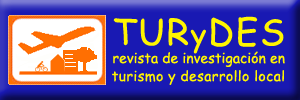
|
Ofertas especiales de Paquetes por Europa con Paris y Londres para los subscriptores de la revista. Visita ya Europa y conoce nuevos lugares y culturas. |
Marta Beatriz FarĂas (CV), Ana Elizabeth de la Puente y Sonia Sánchez
Resumen
El presente proyecto, se desprende desde el Programa: “Patrimonio Natural y Cultural de la Provincia de La Rioja” y está siendo abordado desde Instituto de Investigación de Desarrollo Humano.
El área de estudio en el que se lleva a cabo esta investigación, es el Dpto. Castro Barros, ubicado al norte de la ciudad Capital de la provincia de La Rioja, a 70 km. de distancia y una altura promedio de 10331 msnm.
Está compuesto por numerosos pueblos en el interior de la sierra del Velasco, que cuenta con un clima agradable y una variedad de atractivos naturales y culturales; destacándose pequeñas iglesias, arquitectura antigua y tradiciones.
Dpto. Castro Barros, llamado así por llevar el nombre del Presbítero y Obispo Pedro Ignacio de Castro Barros, quien nos represento en el Congreso de Tucumán en 1.816 y dio todo su apoyo a la Revolución de Mayo y en 1.813; también fue elegido Diputado en la Asamblea General Constituyente, reunida en Buenos Aires en ese año.
También, lo llaman la Costa Riojana, por tratarse de pueblos que se localizan al oeste de la capital; a un costado del Sistema Montañoso de las Sierras del Velasco.
La finalidad de esta investigación, es contar con un mapa turístico de la provincia que contenga información sobre la situación actual del patrimonio turístico, tomando como estudio diferentes departamentos que la componen.
En una primera etapa, se llevo a cabo un estudio excautivo y sistemático del Dpto Capital; en un nivel de investigación exploratoria, para luego continuar trabajando con el resto de los departamentos.
Con el inventario del patrimonio turístico, se busca realizar una evaluación objetiva (cualitativa y cuantitativa) de los atractivos y recursos de los cuales dispone el Dpto. Castro Barros; con el fin de seleccionar aquellos de uso turístico inmediatos o para establecer acciones de mejoramiento.
El inventario, se realizo a partir de la relación de cuatro componentes: atractivos turísticos, planta turística, infraestructura y superestructura, tanto de los atractivos naturales como culturales.
A partir de la información obtenida del relevamiento de datos, se realizará el ordenamiento, jerarquización y análisis de la información; que es la etapa en que se encuentra el proyecto actualmente.
Abstract
This project follows from the program "Natural and Cultural Heritage of the Province of La Rioja" and is being approached from the Institute of Human Development Research Center under the Research and Technological Innovation –CENIIT and the Department of Science and Technology, National University of La Rioja.
The area of study that is carried out this research is the Castro Barros Department, located north of the capital city of the province of La Rioja, 70 km. distance and an average height of 10331 meters.
It consists of many villages in the interior of the mountain range of Velasco, which has a pleasant climate and a variety of natural and cultural attractions, highlighting small churches, ancient architecture and traditions.
Castro Barros Department, named after bear the name of the priest and Bishop Pedro Ignacio de Castro Barros, who represent us in the Congress of Tucuman in 1816 and gave its full support to the May Revolution and in 1813, also was elected deputy in Constituent General Assembly, meeting in Buenos Aires in that year.
Also, call the Coast Rioja, because it is people who are located west of the capital, on one side of the Sierra mountain range of Velasco.
The purpose of this research is to have a tourist map of the province that contains information about the current state of heritage tourism, taking as study different departments within it.
In a first stage, carried out a systematic study of the Department excautivo Capital, in an exploratory level, then continue working with other departments.
With an inventory of tourism assets, we seek an objective assessment (qualitative and cuantitativo) of the attractions and resources which has the Castro Barros Department, in order to select those for tourist use or to establish immediate improvement actions.
The inventory was conducted from the ratio of four components: attractions, tourist facilities, infrastructure and superstructure, both natural and cultural attractions.
From the information obtained from survey data, will take place on order, hierarchy and analysis of information, which is the stage where the project is currently.
Palabras Claves: Patrimonio, Turismo, Castro Barros, Situación Ambiental.
TURyDES es una revista académica iberoamericana, editada y mantenida por el Grupo eumed●net de la Universidad de Málaga.
Para publicar un artículo en esta revista vea "Sobre TURyDES ".
Para cualquier comunicación, envíe un mensaje a turydes@eumed.net

|
Ofertas especiales de Paquetes por Europa con Paris y Londres para los subscriptores de la revista. Visita ya Europa y conoce nuevos lugares y culturas. |